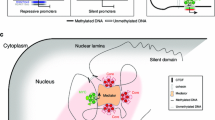Abstract
Purpose
To study gene expression at single embryonic stem cell colony levels with a new RT-PCR protocol.
Methods
Forty-five mouse ES cell colonies were retrieved at the 5th, 10th, 15th, 20th and 25th passages. The pluripotent state was analyzed for OCT-4 and Nanog, and β-actin as a control for the presence of templates. RT-PCR was done using the SuperScript™ III CellsDirect cDNA Synthesis System. Every 2 or 3 days just before passage, a single colony was loaded into a 0.5 ml PCR tube containing 10 μl of resuspension buffer using a pulled glass pipette.
Results
The RT-PCR protocol was completed in less then 150 min. All colonies were positive for OCT-4 and β-actin and 42 out of 45 were positive for Nanog.
Conclusions
This protocol requires as little as 10 pg of total RNA starting material and is therefore useful for low cell number tissues, such as single stem cell colonies or preimplantation embryonic materials.



Similar content being viewed by others
References
Wobus AM, Boheler KR. Embryonic stem cells: prospects for developmental biology and cell therapy. Physiol Rev 2005;85:635–78.
Henderson JK, Draper JS, Baillie HS, Fishel S, Thomson JA, Moore H, et al. Preimplantation human embryos and embryonic stem cells show comparable expression of stage-specific embryonic antigens. Stem Cells 2002;20(4):329–37.
Strachan T, Read AP. Analyzing DNA and gene structure, variation and expression. In: Human molecular genetics. 3rd ed. New York: Garland Science; 2003. p. 181–204.
Niwa H, Miyazaki J, Smith AG. Quantitative expression of Oct-3/4 defines differentiation, dedifferentiation or self-renewal of ES cells. Nat Genet 2000;24:372–6.
Chambers I, Colby D, Robertson M, Nichols, Lee S, Tweedie, et al. Functional expression cloning of Nanog, a pluripotency sustaining factor in embryonic stem cells. Cell 2003;113:643–55.
Hart A, Hartley L, Ibrahim M, Ibrahim. Identification, cloning and expression analysis of the pluripotency promoting Nanog genes in mouse and human. Dev Dyn 2004;230:187–98.
Sato N, Meijer L, Skaltsounis L, Greengard, Brivanlou A. Maintenance of pluripotency in human and mouse embryonic stem cells through activation of Wnt signaling by a pharmacological GSK-3-specific inhibitor. Nat Med 2004;10:55–63.
Nagy A, Gertsenstein M, Vintersten K, Behinger R. Techniques for visualizing gene products, cells, tissues, and organ systems. In: Manipulating the mouse embryo: a laboratory manual. 3rd ed. Cold Spring Harbor: Cold Spring Harbor Laboratory; 2003. p. 629–706.
Hay DC, Sutherland L, Clark J, Burdon T. Oct-4 Knockdown induces similar patterns of endoderm and trophoblast differentiation markers in human and mouse embryonic stem cells. Stem Cells 2004;22:225–35.
Nagy A, Gertsenstein M, Vintersten K, Behinger R. Isolation and culture of blastocyst-derived stem cell lines. In: Manipulating the mouse embryo: a laboratory manual. 3rd ed. Cold Spring Harbor: Cold Spring Harbor Laboratory Press; 2003. p. 359–97.
Ivanova NB, Dimos JT, Schaniel C, Hackney JA, Moore KA, Lemischka IR. A stem cell molecular signature. Science 2002;298:601–4.
Rao RR, Stice SL. Gene expression profiling of embryonic stem cells leads to greater understanding of pluripotency and early developmental events. Biol Reprod 2004;71:1772–8.
Wei CL, Miura T, Robson P, Lim SK, Xu XQ, Lee MYC, et al. Transcriptome profiling of human and murine ESCs identifies divergent paths required to maintain the stem cell state. Stem Cells 2005;23:166–85.
Ramalho-Santos M, Yoon S, Matsuzaki Y, Mulligan RC, Melton DA. “Stemness”: transcriptional profiling of embryonic and adult stem cells. Science 2002;298:597–600.
Krussel JS, Simon C, Rubio MC, Pape AR, Wen Y, Huang HY, et al. Expression of interleukin-1 system mRNA in single blastomeres from human preimplantation embryos. Hum Reprod 1998;13(8):2206–11.
Stewart MH, Bosse M, Chadwick K, Menendez P, Bendall SC, Bhatia M. Clonal isolation of hESCs reveals heterogeneity within the pluripotent stem cell compartment. Nat Meth 2006;3(10):807–15.
Takahashi K, Yamanaka S. Induction of pluripotent stem cells from mouse embryonic and adult fibroblast cultures by defined factors. Cell 2006;126:663–76.
Evans MJ, Kaufman MH. Establishment in culture of pluripotential cells from mouse embryos. Nature 1981;292:154–6.
Downing GJ, Battey JF Jr. Technical assessment of the first 20 years of research using mouse embryonic stem cell lines. Stem Cells 2004;22:1168–80.
Krussel JS, Huang HY, Wen Y, Kloodt AR, Bielfeld P, Polan, ML. Different patterns of interleukin-1b- (IL-1b), interleukin-1 receptor antagonist- (IL-1ra) and interleukin-1 receptor type I- (IL-1R, tI) mRNA-expression in single preimplantation mouse embryos at various developmental stages. J Reprod Immunol 1997;34:103–20.
Acknowledgments
This work is in partial fulfillment of the requirements for the Ph.D. degree of RLC Tavares. We thank Dr. Fabiana Kim for initial technical support. Editorial assistance by Ms. Andrea Victor is greatly appreciated. Our research was supported by the Center for Reproductive Medicine and Infertility, Weill Medical College of Cornell University and a grant from CAPES/Brazilian Government (BEX1475/03-7) to Dr. RLC Tavares.
Author information
Authors and Affiliations
Corresponding author
Additional information
A gene expression study at the single ES cell colony level is described which may improve previous procedures that use materials from pooled colonies.
Rights and permissions
About this article
Cite this article
Tavares, R.L.C., Xu, K., Zhang, C. et al. A specific and quick gene expression study in mouse ES cells. J Assist Reprod Genet 24, 366–372 (2007). https://doi.org/10.1007/s10815-007-9141-x
Received:
Accepted:
Published:
Issue Date:
DOI: https://doi.org/10.1007/s10815-007-9141-x




